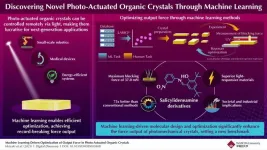(Press-News.org)
Materials that convert external stimuli into mechanical motion, known as actuators, play a crucial role in robotics, medical devices, and other advanced applications. Among them, photomechanical crystals deform in response to light, making them promising for lightweight and remotely controllable actuation. Their performance depends on factors such as molecular structures, crystal properties, and experimental conditions.
A key performance indicator of these materials is the blocking force—the maximum force exerted when deformation is completely restricted. However, achieving high blocking forces remains challenging due to the complex interplay of crystal characteristics and testing conditions. Understanding and optimizing these factors is essential for expanding the potential applications of photomechanical crystals.
In a step toward optimizing the output force of photo-actuated organic crystals, researchers from Waseda University have leveraged machine learning techniques to enhance their performance. The study was led by Associate Professor Takuya Taniguchi from the Center for Data Science, along with Mr. Kazuki Ishizaki and Professor Toru Asahi, both from the Department of Advanced Science and Engineering, Graduate School of Advanced Science and Engineering at Waseda University. Their findings were published online in Digital Discovery on 20 March 2025.
“We noticed that machine learning simplifies the search for optimal molecules and experimental parameters,” says Dr. Taniguchi. “This inspired us to integrate data science techniques with synthetic chemistry, enabling us to rapidly identify new molecular designs and experimental approaches for achieving high-performance results.”
In this study, the team utilized two machine learning techniques: LASSO (least absolute shrinkage and selection operator) regression for molecular design and Bayesian optimization for selecting experimental conditions. The first step led to a material pool of salicylideneamine derivatives, while the second enabled efficient sampling from this pool for real-world force measurements. As a result, the team successfully maximized the blocking force, achieving up to 3.7 times greater force output compared to previously reported values and accomplishing this at least 73 times more efficiently than conventional trial-and-error method.
“Our research marks a significant breakthrough in photo-actuated organic crystals by systematically applying machine learning,” says Dr. Taniguchi. “By optimizing both molecular structures and experimental conditions, we have demonstrated the potential to dramatically enhance the performance of light-responsive materials.”
The proposed technology has broad implications for remote-controlled actuators, small-scale robotics, medical devices, and energy-efficient systems. Because photo-actuated crystals respond to light, they enable contactless and remote operation, making them ideal robotic components working in confined or sensitive environments. Their ability to generate force noninvasively with focused light could also be valuable for microsurgical tools and drug delivery mechanisms that require precise, remote actuation.
By leveraging a cleaner energy input—light irradiation—while maximizing mechanical output, these materials hold promise for eco-friendly manufacturing processes and devices aimed at reducing overall energy consumption. “Beyond improving force output, our approach paves the way for more sophisticated, miniaturized devices, from wearable technology to aerospace engineering and remote environmental monitoring,” Dr. Taniguchi adds.
In conclusion, this study highlights the power of a machine learning–driven strategy in accelerating the development of high-performance photo-actuated materials, bringing them one step closer to real-world applications and commercial viability.
***
Reference
Authors: Kazuki Ishizaki1, Toru Asahi1, and Takuya Taniguchi2
DOI: 10.1039/D4DD00380B
Affiliations: 1Department of Advanced Science and Engineering, Graduate School of Advanced Science and Engineering, Waseda University
2Center for Data Science, Waseda University
About Waseda University
Located in the heart of Tokyo, Waseda University is a leading private research university that has long been dedicated to academic excellence, innovative research, and civic engagement at both the local and global levels since 1882. The University has produced many changemakers in its history, including nine prime ministers and many leaders in business, science and technology, literature, sports, and film. Waseda University has strong collaborations with overseas research institutions and is committed to advancing cutting-edge research and developing leaders who can contribute to the resolution of complex, global social issues. The University has set a target of achieving a zero-carbon campus by 2032, in line with the Sustainable Development Goals (SDGs) adopted by the United Nations in 2015.
To learn more about Waseda University, visit https://www.waseda.jp/top/en
About Associate Professor Takuya Taniguchi from Waseda University
Takuya Taniguchi is an Associate Professor at the Center for Data Science at Waseda University, Japan. He received a Doctor of Engineering degree from the Department of Advanced Science and Engineering, Graduate School of Advanced Science and Engineering, Waseda University, in 2019. His research areas of interest include structural organic chemistry, physical organic chemistry, organic functional materials, materials informatics, and materials science. His publications have received over 500 citations.
END
Colorectal cancer (CRC), a type of cancer that affects the large intestine and rectum, is one of the leading causes of cancer-related deaths worldwide. The mutational landscape of CRC is well characterized, revealing key pathogenic genetic abnormalities that drive carcinogenesis (cancer development) and disease progression. Moreover, a step-wise colorectal carcinogenesis model has been proposed wherein normal epithelial cells transition to adenoma (non-cancerous tumor) and then to carcinoma (cancerous tumor) as they sequentially acquire genetic mutations.
Mutations ...
Vision is one of the most complex functions of our brain and requires a seamless interaction between many different brain structures to decode shapes, colours, depths, and movements and turn them into a meaningful whole. Just like other brain functions, vision also depends on a balanced and controlled interaction between the chemical signals that "activate" and "brake" activity in the eye's cells – much like the accelerator and brake of a car. In research, the "brake" is known as GABA, which stands for gamma-aminobutyric ...
Barcelona, 15th April 2025. – Pancreatic cancer is one of the most aggressive cancers and has one of the lowest survival rates—only 10% after five years. One of the factors contributing to its aggressiveness is its tumor microenvironment, known as the stroma, which makes up the majority of the tumor mass and consists of a network of proteins and different non-tumor cells. Among these, fibroblasts play a key role, helping tumor cells to grow and increasing their resistance to drugs. Now, a study led by researchers from the Hospital del Mar Research Institute, IIBB-CSIC-IDIBAPS, ...
April 15, 2025 | Portland, Oregon—A new study in the journal Fisheries shows how a salmon-focused ecosystem protection strategy in the North Pacific can deliver meaningful results in the global drive to protect biodiversity.
The approach, called the stronghold strategy, aims to proactively protect the world’s greatest remaining “strongholds”—a select group of salmon, steelhead, and trout systems that collectively comprise 119 distinct watersheds. According to Wild Salmon Center President & CEO Guido Rahr—lead author of the peer-reviewed study—salmonids center the strategy because they are both iconic and globally recognized ...
Researchers at the VIB-UGent Center for Medical Biotechnology have discovered a promising strategy to improve treatment responses in multiple myeloma patients by blocking a protein that plays a key role in drug resistance. The study, published in Pharmacological Research, offers a potential new strategy to improve outcomes for patients whose disease has become less responsive to standard therapies.
Multiple myeloma (MM) is a type of blood cancer that affects the bone marrow. Patients are often treated with dexamethasone, a synthetic glucocorticoid frequently used in the clinic to regulate immune responses and slow cancer growth. However, as the disease progresses, many patients develop ...
The sun may rise every morning, but the amount of sunlight reaching the Earth’s surface can substantially vary over decades, according to a perspectives article led by an international research team. The article, published on March 15 in Advances in Atmospheric Science, suggests that stages of “dimming” and “brightening” correspond with increased air pollution and implementation of clean energy solutions, respectively.
“The amount of sunlight — which is solar ...
People with a certain heart valve abnormality are at increased risk of severe heart rhythm disorders, even after successful valve surgery. This is according to a new study from Karolinska Institutet and Karolinska University Hospital in Sweden published in the European Heart Journal. The condition is more common in women and younger patients with valve disorder and can, in the worst case, lead to sudden cardiac arrest.
Mitral annular disjunction, MAD, is a heart abnormality in which the mitral valve attachment ‘slides’. In recent years, the condition has ...
The Titanic sunk 113 years ago on April 14-15, after hitting an iceberg, with human error likely causing the ship to stray into those dangerous waters. Today, autonomous systems built on artificial intelligence can help ships avoid such accidents, but could such a system explain to the captain why it was maneuvering a certain way?
That’s the idea behind explainable AI, which should help human actors trust autonomous systems more. Researchers from Osaka Metropolitan University’s Graduate School of Engineering have developed an explainable AI model for ships that quantifies the collision risk for all vessels ...
In Birmingham, 43% of the population live in the most deprived 10% of neighborhoods in England. It is well known that deprivation can lead to adverse pregnancy outcomes, including low birth weight, premature birth, stillbirths, and neonatal mortality.
Now, researchers there examined the association between demographic, socioeconomic, and lifestyle factors and the risk of adverse birth outcomes in Birmingham and neighboring Solihull, an area much less affected by deprivation.
“Within the study population, there were significant differences in the odds of adverse birth outcomes and the risk factors of adverse birth outcomes by ethnicity ...
If you’re among the 1.5 billion people worldwide using TikTok, you may have come across exceptional “testimonials” like Nikola Tesla or Marie Curie delivering short science-related messages that have garnered millions of views. This is just one of many examples where AI-generated avatars are used to communicate science — a strategy that might also have its drawbacks.
The generation of images and animations through artificial intelligence is a rapidly growing field, constantly improving in quality. Yet many avatars, though realistic, still present minor flaws — glitches, delays, inconsistent ...



